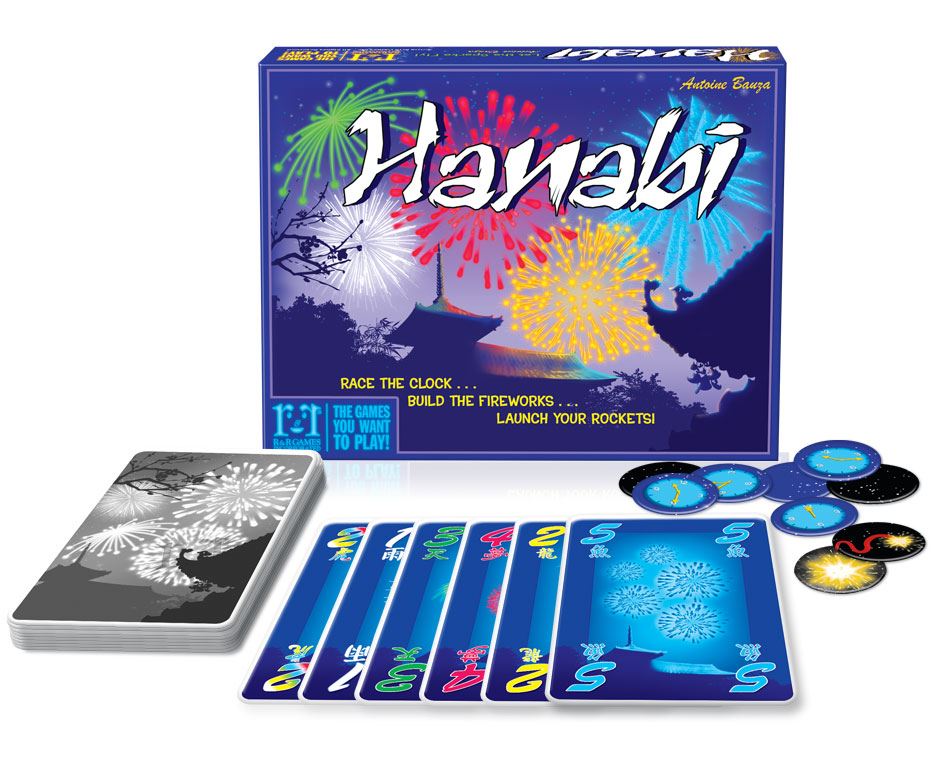Despite the UK’s association with fireworks and autumn, arguably the best time for firing off pyrotechnics is the summertime. The nights are warmer and the skies are often clearer. Also, summer is the kind of season where humanity often feels the desire to do ridiculous things like eating an ice cream on one of Brighton’s several seagull-infested beaches. Which is why Hanabi, a card game where the aim is to put on the greatest display of fireworks the world has ever seen, is such a suitable tabletop experience for this time of year.
Hanabi is also the perfect size for summer because it’s small and light enough to be easily taken to the pub, to a picnic or another outdoorsy locale. But ultimately it’s Hanabi’s gameplay that solidifies it as a fantastic game to bring with you to any summery social occasion, purely due to the fact that it’s incredibly easy to learn and extremely fun to play.
Hanabi is a co-op card game for two to five players that’s all about giving good communication and choosing your actions wisely. This may appear to be a very lighthearted game - and it is! - but it still has its fair share of squeaky-bum moments that could result in either complete success or utter failure. The game’s deck is made up of five sets of coloured cards, each numbered one to five. There are different amounts of each number in every set, with the number one being the most plentiful and the number five being the least.
The aim of the game is to play each numbered card from every set in sequence from one to five without making too many mistakes. This may sound deceptively simple, but there is a pretty major catch in Hanabi - the players cannot see their own cards, only those of their fellow players. Not being able to see your own hand is a huge barrier to completing what is an otherwise very simple objective, but it’s where most of the fun and the challenge comes from. Other players cannot play cards that aren’t in their own hand, instead, they have to rely on the information carefully communicated by their teammates.
At the start of the game, players each draw five cards which they must turn so that the front of the cards are faced away from them and clearly visible to the other players. The players then take turns to perform one of three potential actions - playing a card, discarding a card or giving a clue. Deciding which cards to play and which cards to discard is obviously rather difficult if you can’t see what they are, which is where the players’ teammates come in.
Giving a clue to another teammate requires the players to have at least one clue token to spend - the group starts with eight clues to begin with - and must be information that refers to either a specific number or colour. For example, one player might be holding three fours on their hand, so the current player could spend a clue to tell them about those fours. However, it’s up to the person who receives this information to remember which cards the information they’re given refers to.
Giving a good clue in Hanabi is important, not just because the player is relying on that information to make good decisions, but also because clues are a finite resource and require players to discard cards in order to get them back. This inevitably leads to a situation where players are forced to either play or discard cards because they’ve run out of clues - which is terrible if you have absolutely no idea what’s in your hand. Playing the wrong card results in the players losing a life. Three lives gone and the players are forced to end their fireworks show prematurely, taking whatever score they’ve managed to accrue up to that point.
Things get even trickier when you consider that playing the wrong card also forces the player to discard it. The higher-numbered the card, the fewer there are to spare to an unfortunate mishap, with the fives of each set being completely indispensable if players want to successfully complete any rows. However, all is not lost. Even if players do not manage to finish any of their rows, their achievements will be recognised as long as they have made a decent amount of progress with at least some of their sets.
Hanabi ends when either the players run out of lives, the last card is drawn from the deck or - miraculously - the players have managed to play every card in the right order. Should the players have pulled off the aforementioned incredible feat, then they are considered firework masters and can pat themselves on the back. In the more likely event of players running out or cards or lives, they must count up the highest card of each row they’ve managed to play in order to get their total amount - the rulebook will then inform them of how well they did in the narrative of the game.
Despite how unusual Hanabi’s main mechanic might be to newer players - it can result in a bit of a Marmite situation of ‘you either hate it or love it’ - it’s still an incredibly accessible game thanks to how simple the rules are and how quick the games go. It’s also pretty cheap, usually priced at around £9.99, and easy to get hold of. Just like a firework display, Hanabi is an utter crowdpleaser, regardless of the audience.
